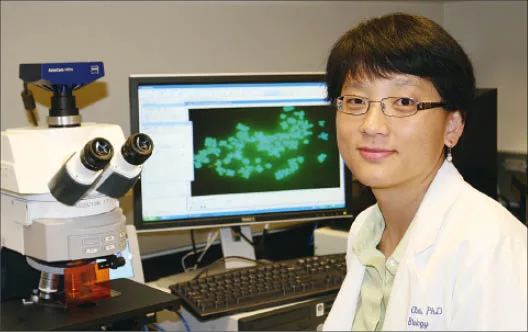What if cancer-cells couldn't reproduce?
Regulatory proteins that allow cell reproduction are focus of research at Washington State University Spokane

A researcher at Washington State University Spokane is studying how cancer cells might be altered to halt their reproduction and eventually make them die.
The researcher, Weihang Chai, an assistant professor in WSU's School of Molecular Biosciences and the WWAMI medical education program, has been studying the science of telomeres, the protective tips of a cell's two DNA strands, which allow cells to divide and reproduce. When the protective structure on the DNA strands becomes too short, the cells are no longer able to reproduce and will age and die.
Cancer cells, however, are able to prevent the shortening of their telomeres. Because of that, they are able to reproduce forever, Chai says.
Cancer cells have a special enzyme, called telomerase, that allows one of the two strands of DNA to avoid the natural shortening the DNA strands of normal cells experience, Chai says.
The extension of the other strand is controlled by specific proteins, two of which have been identified so far, rather than by the telomerase enzyme. The reason each of the two strands' telomeres is regulated by different chemicals is because of variations in the complementary "base pairs" that compose each separate DNA strand: adenine, guanine, thymine, and cytosine, Chai says.
"Base pairs" consist of two of the base chemicals, one on each of the two DNA strands, that are bonded to one another, forming the "rungs" of the twisted, ladder-like double helix formation of a DNA molecule.
Chai's research is specifically focused on determining how to halt the extension of the telomere on the strand that is protein-controlled. Researchers have discovered that the extension of the other strand of the helix can be halted by telomerase inhibitors, but a method to block the function of the proteins responsible for regulating the extension of the second DNA strand has yet to be determined, she says.
"By inhibiting the second strand, you can potentially stop the growth of the cancer cells," she says.
She says, however, that if a method to halt the regulatory proteins is identified, it is not known whether that will stop the telomerase enzyme on the other strand as well.
"We are working on that right now," she says. "It might influence the telomerase, but it may not recognize it. We are working on a lot of new things."
Chai says the study of DNA telomeres is relatively new, compared with the study of the causes of cancer, and only has picked up speed in the last 20 or so years.
"The main purpose in the field is that scientists want to find how the telomeres are maintained in cancer cells," she says. "By understanding this, we can design a targeted approach to help kill these cells."
An example of how telomeres work on normal cells can be explained through the healing of a wound. Chai says that normally, new cells will be grown from the surrounding tissue of a wound to replace the damaged or lost cells. In younger people, the healing process occurs much faster than in someone who is older, because the older person's cells have aged and not as many of them are able to reproduce because their telomeres are too short.
"Eventually cells stop growing and age so they can't divide anymore. They are too short to divide so they have to stop," she says.
Chai says that even though scientists have been studying the telomerase enzyme for decades now, its only known property is its ability to elongate the telomere of a single DNA strand.
"Telomerase is the main reason why cancer cells reproduce continually. Without it, they would function like a normal cell," she says.
While inhibitors of the enzyme are known, the key now is finding a way to target the cancer-specific protein, which causes the other DNA strand to elongate itself endlessly.
Chai says that because cancer cells are mutated cells, it's possible they're able to manipulate these proteins in ways that allow them to work better and longer than in normal cells.
She says clinical trials that are under way have combined a telomerase specific inhibitor with other cancer-treatment drugs. Such a combination of drugs can make the overall treatment more effective, Chai says. However, she says it takes time for the inhibitor to shorten the telomeres to the point at which the cells are no longer able to divide.
"With two treatments, you can definitely make the cells die faster," she says.
Yet, cancer cells are known to mutate and form resistance to treatment drugs over a period of time, Chai says, and during treatments in which a telomerase inhibitor is administered, this also can occur.
If Chai and her team are able to figure out a way to halt the growth of the protein-regulated DNA strand, killing the cancerous cells may take less time than with the telomerase inhibitor alone, she says.
She says that theoretically, stopping the growth of only one of the strands should be enough to cause the cancer cell to die, but because of their known ability to mutate, that might not be the case for every cancer patient.
"We don't know if you can use one or the other. Theoretically, using one of these two methods should be enough," she says.
Two post-doctoral researchers, a graduate student, and a lab assistant work with Chai on her lab research. There, they study a cancer cell line that is more than 50 years old, and is the most used cancer cell line in the world, she says. The cells her team is using were taken from a patient during the 1950s and have since been grown in labs over the world to be used for study.
She says she is the only researcher at WSU who studies this particular trait of cancer cells, and is one of only a few other researchers in the nation who study protein synthesis in telomere elongation.
Chai's work here is funded in part by the National Institutes of Health, the American Cancer Society, and the state of Washington.
She says her goal is to be able to facilitate additional cancer research by discovering a way to inhibit the regulatory proteins in the cancer cells that keep them from dying.
"I am optimistic because even though there are still cancers we cannot cure, we have already cured a lot of people," Chai says.
Chai received her doctorate in microbiology from Cornell University in 1999 and went on to the University of Texas Southwestern's medical center in Dallas, where she started her research of DNA telomeres. She says that in working with other labs across the country, she and her peers discovered that DNA telomeres become shorter each time a cell divides.
Chai came to WSU Spokane in 2008 as part of the WWAMI program, which was put in place here about 35 years ago to train medical students from five states in the region in the hope that they would return to their community to practice after receiving their training.
Students in the WWAMI program here complete their clinical education locally, but receive their medical degrees from the University of Washington.
Related Articles

_c.webp?t=1763626051)

